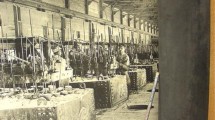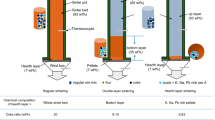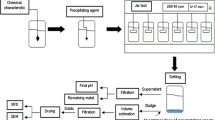Abstract
The sintering characteristics of a typical Missouri lead concentrate were determined for two types of raw sinter mix: conventionally prepared and pelletized. The important sintering characteristics are sulfur elimination, sinter strength, production rate of sinter, permeability of the sinter bed, and bed temperature. These characteristics were analyzed statistically, and are described by an empirical model, in which proportion of returns, moisture content, air flow, bed height, size distribution of returns, and ignition time are the independent variables. The characteristics of a conventionally prepared sinter mix are most strongly affected by the moisture content of the raw mix. The characteristics of a pelletized sinter mix are not strongly affected by any of the independent variables. However, a pelletized charge gave a much higher production rate and a higher sinter quality as compared to a conventionally prepared charge. Recycle of off gas has a large deleterious effect on sinter production rate and quality. The results provide suggestions for improved operation of sinter plants.
Similar content being viewed by others

References
W. McA. Manson:Aus. Inst. Min. Met., 1964, vol. 211, pp. 115–34.
D. F. Bail, J. Dartnell, J. Davidson, A. Grieve, and R. Wild:Agglomeration of Iron Ores, American Elsevier Publishing Company, New York, NY, 1973, pp. 95–115.
D. R. Blaskett: Sintering Symposium, Port Pine, South Australia,Aust. Inst. Min. Met., 1958, pp. 61-70.
E. W. Voice and R. Wild: Sintering Symposium, Port Pine, South Australia,Aust. Inst. Min. Met., 1958, pp. 21-60.
W. McA. Manson: Sintering Symposium, Port Pirie, South Australia,Aust. Inst. Min. Met., 1958, pp. 143-74.
W. McA. Manson: internal report R/1226, The Broken Hill Associated Smelters Pty. Ltd., P.O. Box 219, Port Pirie, South Australia, December 1959.
D. F. Ball, J. Dartnell, J. Davidson, A. Grieve, and R. Wild:Agglomeration of Iron Ores, American Elsevier Publishing Company, New York, NY, 1973, pp. 119–26.
S. E. Woods and C. F. Harris:Chemical Engineering in the Metallurgical Industry (Proc. Symp.), London Inst. of Chem. Engr., Edinburgh, September 1963, pp. 77–86.
G.S.C. Beverage:Chemical Engineering in the Metallurgical Industry (Proc. Symp.), London Inst. of Chem. Engr., Edinburgh, September 1963, pp. 87–104.
I. Dash and E. Rose:Automation in Mining, Mineral and Metal Processing (Proc. Symp.), Johannesburg, September 1976, pp. 649-59.Ironmaking, Steelmaking, Intl. Fed. of Autom. Control, 1978, vol. 5, pp. 25-31,Ind. Eng. Chem. Process Des. Dev., 1979, vol. 18, pp. 67-72.
D. Robertson: personal communication, Imperial College, London, England, September 25, 1979.
E. Kreyszig,Advanced Engineering Math, John Wiley and Sons, New York, NY, 1972, pp. 653–72.
C.R. Hicks:Fundamental Concepts in the Design of Experiments, Holt, Rinehart, and Winston, New York, NY, 1964, pp. 75–218.
G.E. P. Box and J. S. Hunter:Technometrics, 1961, vol. 3, pp. 311–51.
E. Rabinowicz:An Introduction to Experimentation, Addison-Wesley, Reading, MA, 1970, pp. 30–96.
N.R. Draper and H. Smith:Applied Regression Analysis, John Wiley and Sons, New York, NY, 1966, pp. 128–262.
R. Schuhmann, Jr.: “Principles of Communition. I. Size Distributions and Surface Calculations,” Technical Publication 1189, AIME, 1940.
J. H. Strassburger, ed.,Blast Furnace Theory and Practice, Gordon and Breach Science Publishers, New York, NY, 1969, vol. 1, pp. 282, 286.
H. Rajcevic: personal communication, AMAX Research Laboratory, June 1980.
Author information
Authors and Affiliations
Rights and permissions
About this article
Cite this article
Knoepke, J.R., Tsai, HY. & Morris, A.E. Factors influencing the production rate and quality of lead sinter. Metall Trans B 13, 15–29 (1982). https://doi.org/10.1007/BF02666951
Received:
Issue Date:
DOI: https://doi.org/10.1007/BF02666951



